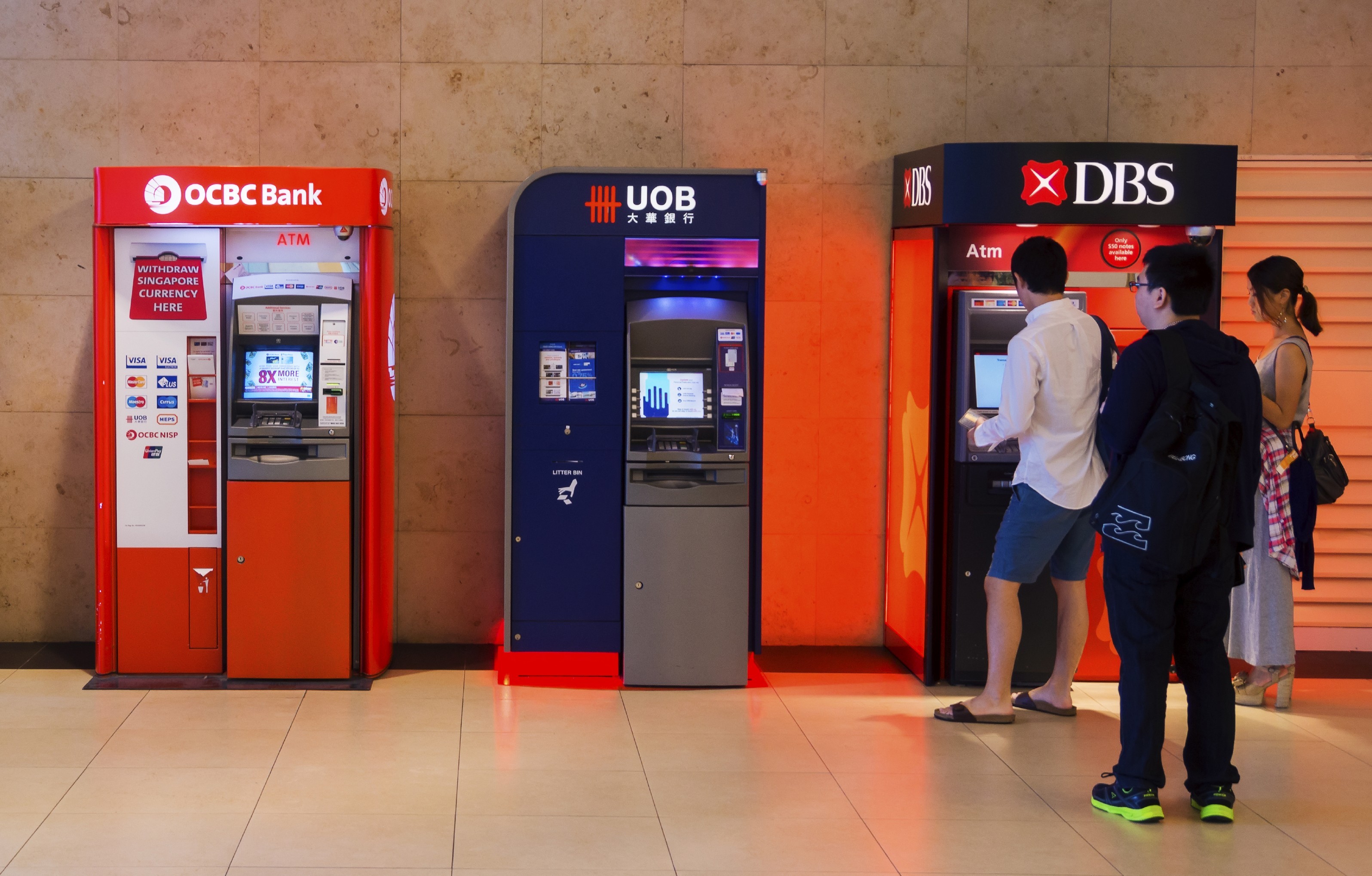
Banks’ net interest income entering low growth phase.
The Singapore banks’ Asian markets are in a credit cycle contraction and Singapore banks have less ability to stretch the already high Loan-To-Deposit Ratios (LDR) further to boost net interest income growth. In this situation, a rising interest rate would likely worsen performance rather than improve it. We expound the following two key risks to a muted net interest income growth:
OCBC: Lowest LDR among the local banks as at 3Q16; but waiting to strike
OCBC’s LDR improved to 83% in 3Q16 after it hit a high of above 88% in 2Q13. Despite having relatively more room to leverage, we expect OCBC to conservatively manage its loan and deposit volume/rates dynamics to maintain LDR at c80%. We expect OCBC’s defensive stance to result in weak net interest income growth in 2017 but the defensive strategy is in line with a contracting credit cycle.
Figure 1: OCBC’s Net Interest Income q-o-q growth and LDR

Source: Company, PSR
UOB: Lending aggressively to riskier borrowers to support net interest income growth
In our previous UOB 3Q16 earnings report, we indicate that UOB was willing to accept higher yields from riskier loans. UOB has the highest average All Currency Liquidity Coverage Ratio (LCR) of 148% by 3Q16 (OCBC: 133% and DBS: 115%). Minimum All Currency LCR required by regulation will be 80% by 2017. As of 3Q16, UOB also have a coverage ratio of 111%, above DBS’ 100% and OCBC 101% (See Figure 6). With higher LCR and coverage ratio compared to peers, we suspect UOB is attempting to manage an optimal balance between higher yields from riskier loans and a high LDR c.85% to keep net interest income growth positive. But the corollary would be the resulting net interest income growth is able to feed the higher provisions needed for the riskier loans.
Figure 2: UOB’s Net Interest Income q-o-q growth and LDR

Source: PSR, company
DBS: Highest LDR among the banks; likely to seek growth from acquisitions
DBS had pushed its LDR up aggressively since 2010 and it is at 89.5% as of 3Q16, the highest amongst the Singapore banks. We believe DBS’ aggressiveness to drive up performance by maintaining high LDR could leave it more vulnerable to liquidity risks and less bandwidth to manage a stable net interest income growth. However, we can expect some support from DBS’ acquisition of ANZ’s wealth management and retail banking business in Singapore, Hong Kong, China, Taiwan and Indonesia. The acquisition provides DBS access to additional S$11bn worth of customer loans, representing 3.74% of DBS’ customer loans and S$17bn worth of customer deposits, representing 5.24% of DBS’ customer deposits. The acquisition is slated for progressive completion from 2Q17 to early 2018. We also expect DBS’ acquisitive trail to continue in order to bolt on more deposits and loans to grow net interest income if they decide to defy the credit cycle contraction in their Asian markets.
Figure 3: DBS’ Net Interest Income q-o-q growth and LDR

Source: PSR, company
Please sign in to view full report.
Important Information
This report is prepared and/or distributed by Phillip Securities Research Pte Ltd ("Phillip Securities Research"), which is a holder of a financial adviser’s licence under the Financial Advisers Act, Chapter 110 in Singapore.
By receiving or reading this report, you agree to be bound by the terms and limitations set out below. Any failure to comply with these terms and limitations may constitute a violation of law. This report has been provided to you for personal use only and shall not be reproduced, distributed or published by you in whole or in part, for any purpose. If you have received this report by mistake, please delete or destroy it, and notify the sender immediately.
The information and any analysis, forecasts, projections, expectations and opinions (collectively, the “Research”) contained in this report has been obtained from public sources which Phillip Securities Research believes to be reliable. However, Phillip Securities Research does not make any representation or warranty, express or implied that such information or Research is accurate, complete or appropriate or should be relied upon as such. Any such information or Research contained in this report is subject to change, and Phillip Securities Research shall not have any responsibility to maintain or update the information or Research made available or to supply any corrections, updates or releases in connection therewith.
Any opinions, forecasts, assumptions, estimates, valuations and prices contained in this report are as of the date indicated and are subject to change at any time without prior notice. Past performance of any product referred to in this report is not indicative of future results.
This report does not constitute, and should not be used as a substitute for, tax, legal or investment advice. This report should not be relied upon exclusively or as authoritative, without further being subject to the recipient’s own independent verification and exercise of judgment. The fact that this report has been made available constitutes neither a recommendation to enter into a particular transaction, nor a representation that any product described in this report is suitable or appropriate for the recipient. Recipients should be aware that many of the products, which may be described in this report involve significant risks and may not be suitable for all investors, and that any decision to enter into transactions involving such products should not be made, unless all such risks are understood and an independent determination has been made that such transactions would be appropriate. Any discussion of the risks contained herein with respect to any product should not be considered to be a disclosure of all risks or a complete discussion of such risks.
Nothing in this report shall be construed to be an offer or solicitation for the purchase or sale of any product. Any decision to purchase any product mentioned in this report should take into account existing public information, including any registered prospectus in respect of such product.
Phillip Securities Research, or persons associated with or connected to Phillip Securities Research, including but not limited to its officers, directors, employees or persons involved in the issuance of this report, may provide an array of financial services to a large number of corporations in Singapore and worldwide, including but not limited to commercial / investment banking activities (including sponsorship, financial advisory or underwriting activities), brokerage or securities trading activities. Phillip Securities Research, or persons associated with or connected to Phillip Securities Research, including but not limited to its officers, directors, employees or persons involved in the issuance of this report, may have participated in or invested in transactions with the issuer(s) of the securities mentioned in this report, and may have performed services for or solicited business from such issuers. Additionally, Phillip Securities Research, or persons associated with or connected to Phillip Securities Research, including but not limited to its officers, directors, employees or persons involved in the issuance of this report, may have provided advice or investment services to such companies and investments or related investments, as may be mentioned in this report.
Phillip Securities Research or persons associated with or connected to Phillip Securities Research, including but not limited to its officers, directors, employees or persons involved in the issuance of this report may, from time to time maintain a long or short position in securities referred to herein, or in related futures or options, purchase or sell, make a market in, or engage in any other transaction involving such securities, and earn brokerage or other compensation in respect of the foregoing. Investments will be denominated in various currencies including US dollars and Euro and thus will be subject to any fluctuation in exchange rates between US dollars and Euro or foreign currencies and the currency of your own jurisdiction. Such fluctuations may have an adverse effect on the value, price or income return of the investment.
To the extent permitted by law, Phillip Securities Research, or persons associated with or connected to Phillip Securities Research, including but not limited to its officers, directors, employees or persons involved in the issuance of this report, may at any time engage in any of the above activities as set out above or otherwise hold an interest, whether material or not, in respect of companies and investments or related investments, which may be mentioned in this report. Accordingly, information may be available to Phillip Securities Research, or persons associated with or connected to Phillip Securities Research, including but not limited to its officers, directors, employees or persons involved in the issuance of this report, which is not reflected in this report, and Phillip Securities Research, or persons associated with or connected to Phillip Securities Research, including but not limited to its officers, directors, employees or persons involved in the issuance of this report, may, to the extent permitted by law, have acted upon or used the information prior to or immediately following its publication. Phillip Securities Research, or persons associated with or connected to Phillip Securities Research, including but not limited its officers, directors, employees or persons involved in the issuance of this report, may have issued other material that is inconsistent with, or reach different conclusions from, the contents of this report.
The information, tools and material presented herein are not directed, intended for distribution to or use by, any person or entity in any jurisdiction or country where such distribution, publication, availability or use would be contrary to the applicable law or regulation or which would subject Phillip Securities Research to any registration or licensing or other requirement, or penalty for contravention of such requirements within such jurisdiction.
This report is intended for general circulation only and does not take into account the specific investment objectives, financial situation or particular needs of any particular person. The products mentioned in this report may not be suitable for all investors and a person receiving or reading this report should seek advice from a professional and financial adviser regarding the legal, business, financial, tax and other aspects including the suitability of such products, taking into account the specific investment objectives, financial situation or particular needs of that person, before making a commitment to invest in any of such products.
This report is not intended for distribution, publication to or use by any person in any jurisdiction outside of Singapore or any other jurisdiction as Phillip Securities Research may determine in its absolute discretion.
IMPORTANT DISCLOSURES FOR INCLUDED RESEARCH ANALYSES OR REPORTS OF FOREIGN RESEARCH HOUSE
Where the report contains research analyses or reports from a foreign research house, please note:

Jeremy covers primarily the Banking and Finance sector. He has 6 years’ experience in equities related dealing and research roles.
He graduated with Bachelors of Mechanical Engineering from Nanyang Technological University.